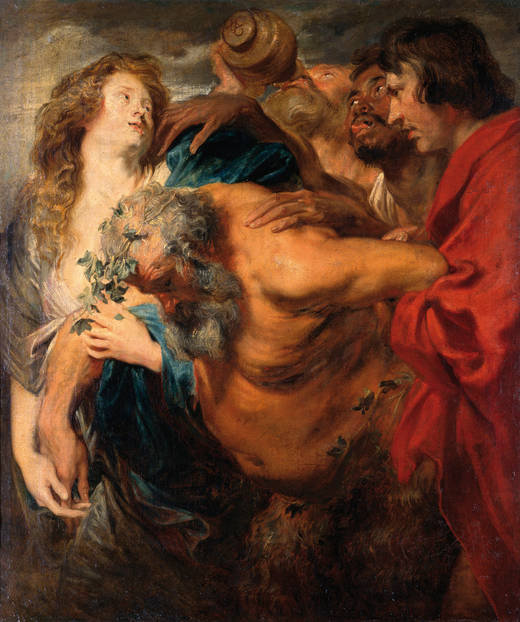The Young Van Dyck
dal 19/11/2012 al 30/3/2013
Segnalato da
19/11/2012
The Young Van Dyck
Prado Museum, Madrid
Paintings such as the Drunken Silenus and The Lamentation are more accomplished than pictures displayed earlier in this exhibition. They show Van Dyck experimenting with modes of expression associated with Venetian and early Netherlandish painting.

Curators: Alejandro Vergara, Senior Curator of Flemish Painting and Northern Schools (to 1700) at the Museo Nacional del Prado, and Friso Lammertse, Curator at the Boijmans van Beuningen Museum, Rotterdam
In 1609 Van Dyck was apprenticed to Hendrik van Balen, one of the leading painters in Antwerp. From there he probably went to the studio of Rubens, but it is not clear when this happened.
Between approximately 1613 and 1618, the year when he registered as a master in the painters’ guild, Van Dyck worked in a variety of styles. In what are probably his earliest pictures he appears tentative in his rendering of anatomy. But even then he shows a strong personality and an experimental bent, which can be seen in his taste for rugged types and textured surfaces, both of which are different from what was common in Antwerp at the time.
Paintings such as the Drunken Silenus and The Lamentation are more accomplished than pictures displayed earlier in this exhibition. They show Van Dyck experimenting with modes of expression associated with Venetian and early Netherlandish painting.
In 1618, the year when he became an independent master, Van Dyck painted four portraits which are among only seven dated works made during his youth. In that same year he probably also painted his first public commission: Christ Carrying the Cross made for the church of the Dominicans in Antwerp.
From approximately 1617 to 1621 Van Dyck worked in the studio of Rubens, and at the same time painted independently, in a style that combines the influence of Rubens with a strong personal manner, visible in the painterly passages and the rugged, un-idealised facial types. Paintings produced in this original mixture of personal and borrowed elements can be seen in this exhibition. They are surprisingly powerful and mature works for an artist who was around 18 to 21 years of age.
Van Dyck collaborated with Rubens from at least 1617 until 1621. In the studio he was one of a team of collaborators that assisted the master painting parts of his pictures, or making variants that Rubens would retouch to some degree. Eventually his status within the studio outgrew that of other collaborators. In March of 1621 Rubens signed a contract where it was stipulated that a group of paintings were to be executed by Rubens himself and by ‘Van Dyck with some other pupils’. None of the other pupils was mentioned by name.
Rubens coached Van Dyck, who reached a point where he could imitate the master´s style to perfection. He made drawings that Rubens used as models in his paintings, and drawings after the master´s pictures so that they could be engraved. Rubens also favoured the young artist by allowing him to use his drawings and models (as occurs in Christ crowned with Thorns).
Throughout his youth we perceive in the art of Van Dyck a sense of quest which is manifest in his frequent changes in style. Probably at the same time as he worked for Rubens and came up with a personal version of the master´s style, he also developed a distinctive manner of his own. This can be seen in works where he used an original cast of characters, where he is less concerned with three-dimensional volume, and where he shows a taste for sweeping strokes of the brush and highly stylised forms. These characteristics are present in paintings such as Saint Sebastian Bound for Martyrdom and The Betrayal of Christ, which are probably among the last paintings that he made before his departure from Antwerp to Italy in the autumn of 1621.
Two versions of a painting of Saint Jerome are exhibited nearby. The practice of making several versions of a composition was not uncommon from the time of the Renaissance, but it was exploited by Van Dyck to an unusual degree, allowing him to increase his profits.
Some of Van Dyck´s portraits can be dated to the period shortly before he left Antwerp in October of 1621 for a seven year stay in Italy. We know this because some portraits show sitters that he met during a visit to the English court, between October 1620 and March 1621. Also, several sources inform us that he painted a portrait of Rubens´s wife Isabella Brant as a gift for his master shortly before he left Antwerp. In these paintings we see the marks of a personal manner, defined by stylised, fluent forms and the elegant poses. These would become trademark features later in his life, making him one of the most influential portrait painters in European art. It is remarkable that an artist who had been so close to Rubens could also paint in such a personal, fluid way; it may be seen as a measure of his will to be independent.
Image: Drunken Silenus, Van Dyck, oil on canvas, 107 x 90 cm, Dresden, Gemäldegalerie Alte Meister der Staatlichen Kunstsammlungen
Communications Department
International Media Relations
+ 34 91 330 29 60
press@museodelprado.es
Prado Museum
Calle Ruiz de Alarcon, 23 - Madrid
Opening hours
Monday to Saturday from 10am to 8pm. Sunday and holidays from 10am to 7pm
Ticket price
General: 12 €
General + Guide: 22 €
Reduced: 6 €
Free
Tourist group: 10 € / person (only through CAV)
Cultural group: 6 €
Educational group: 0 €



